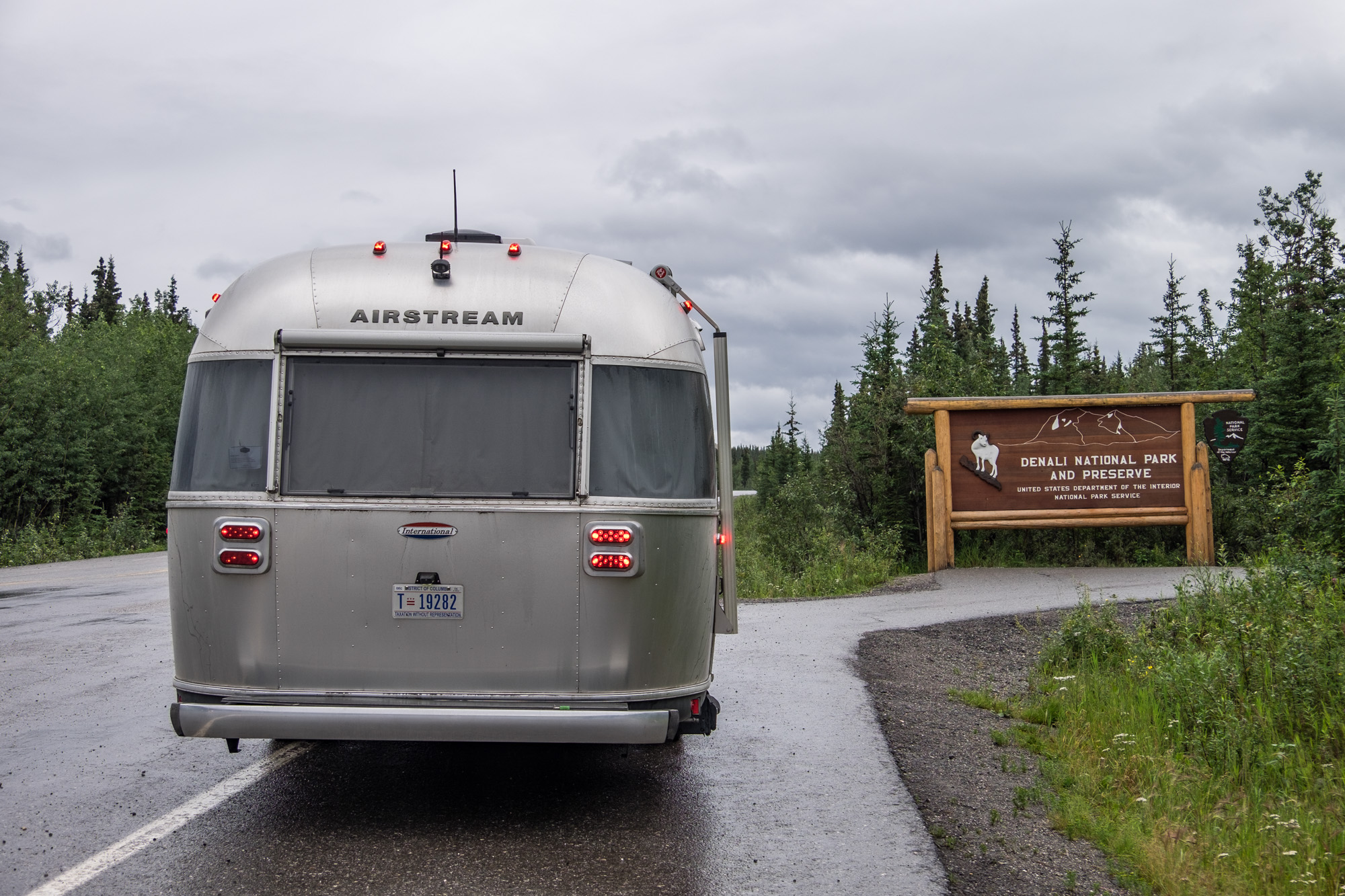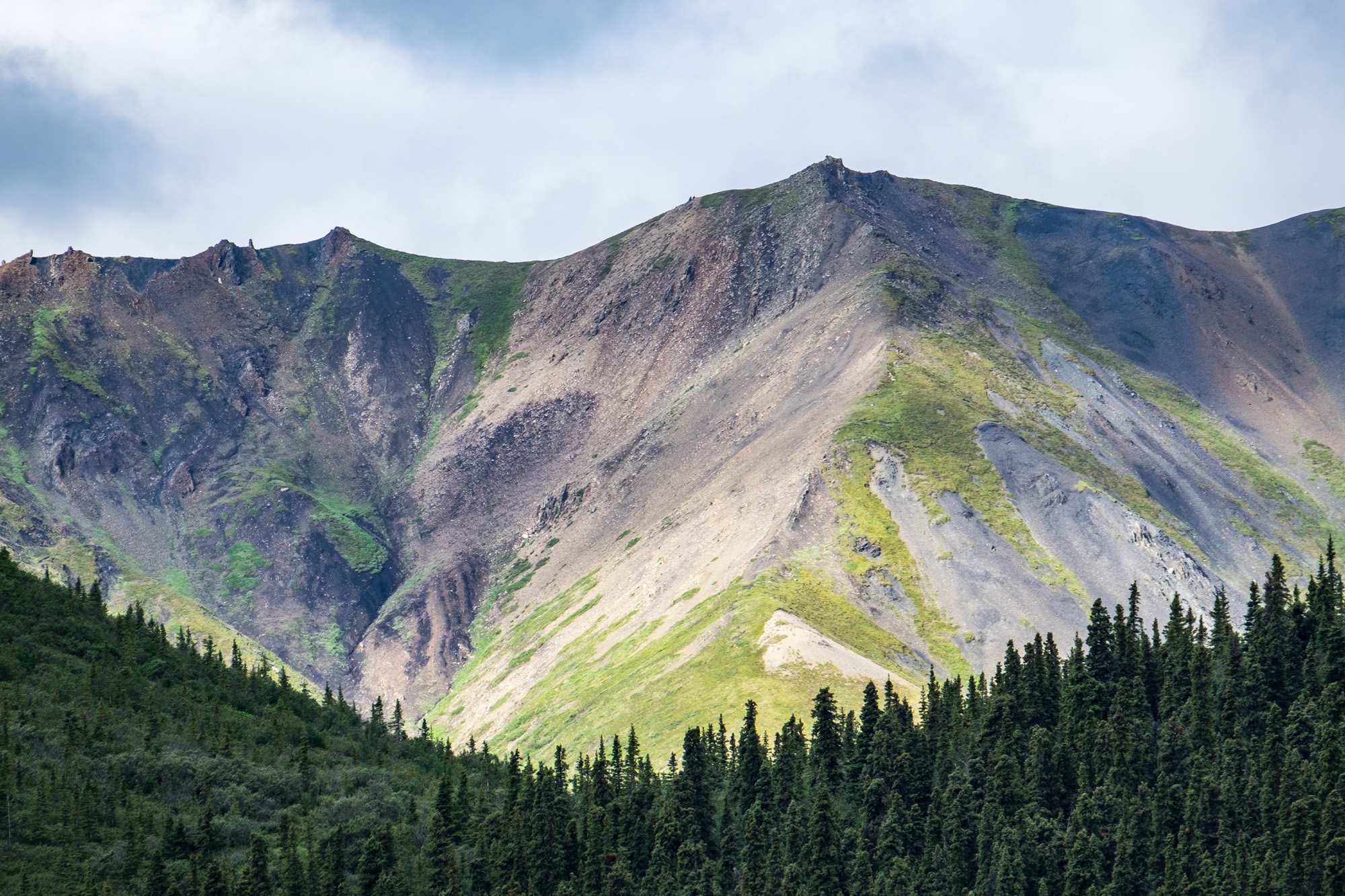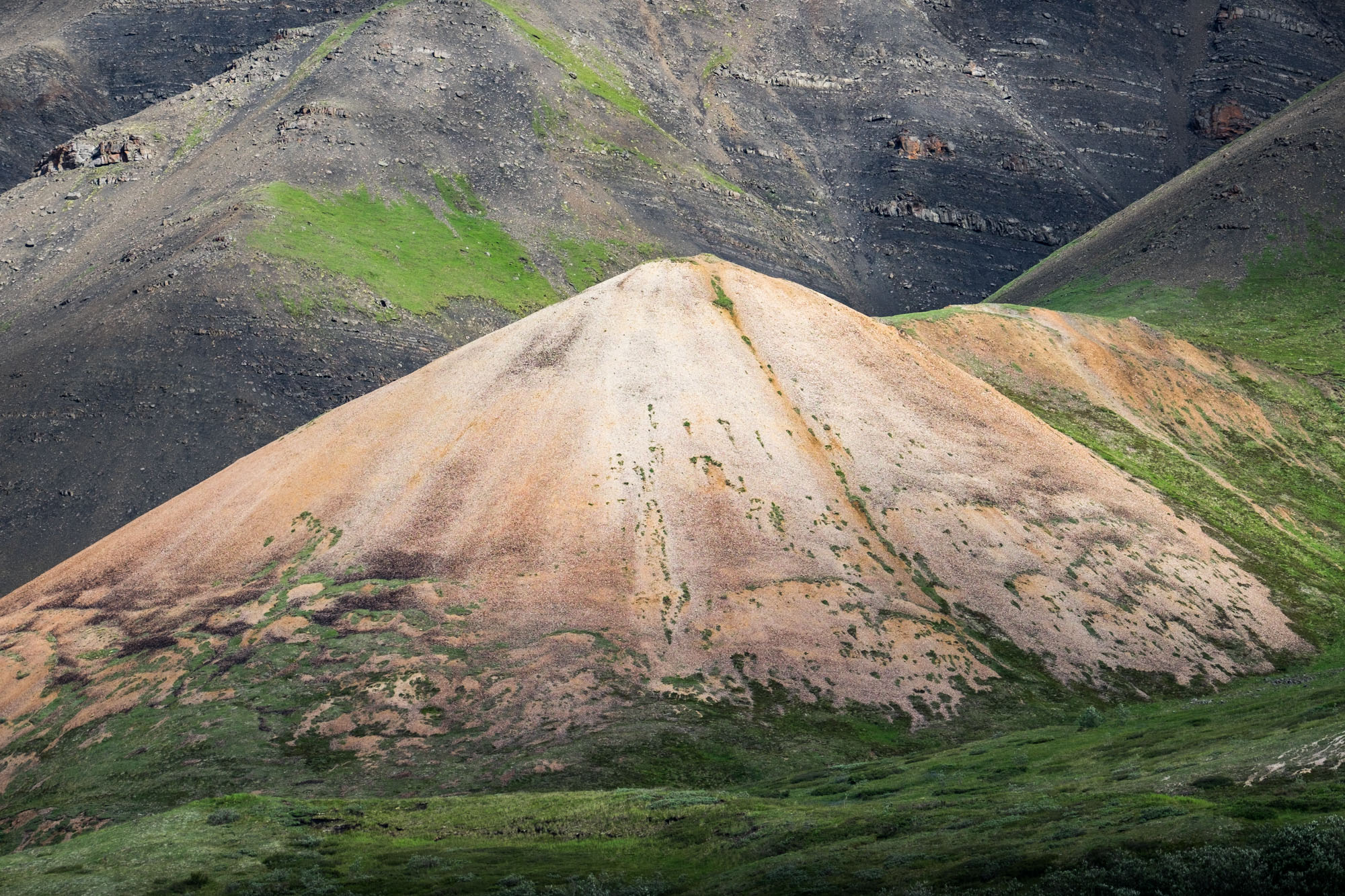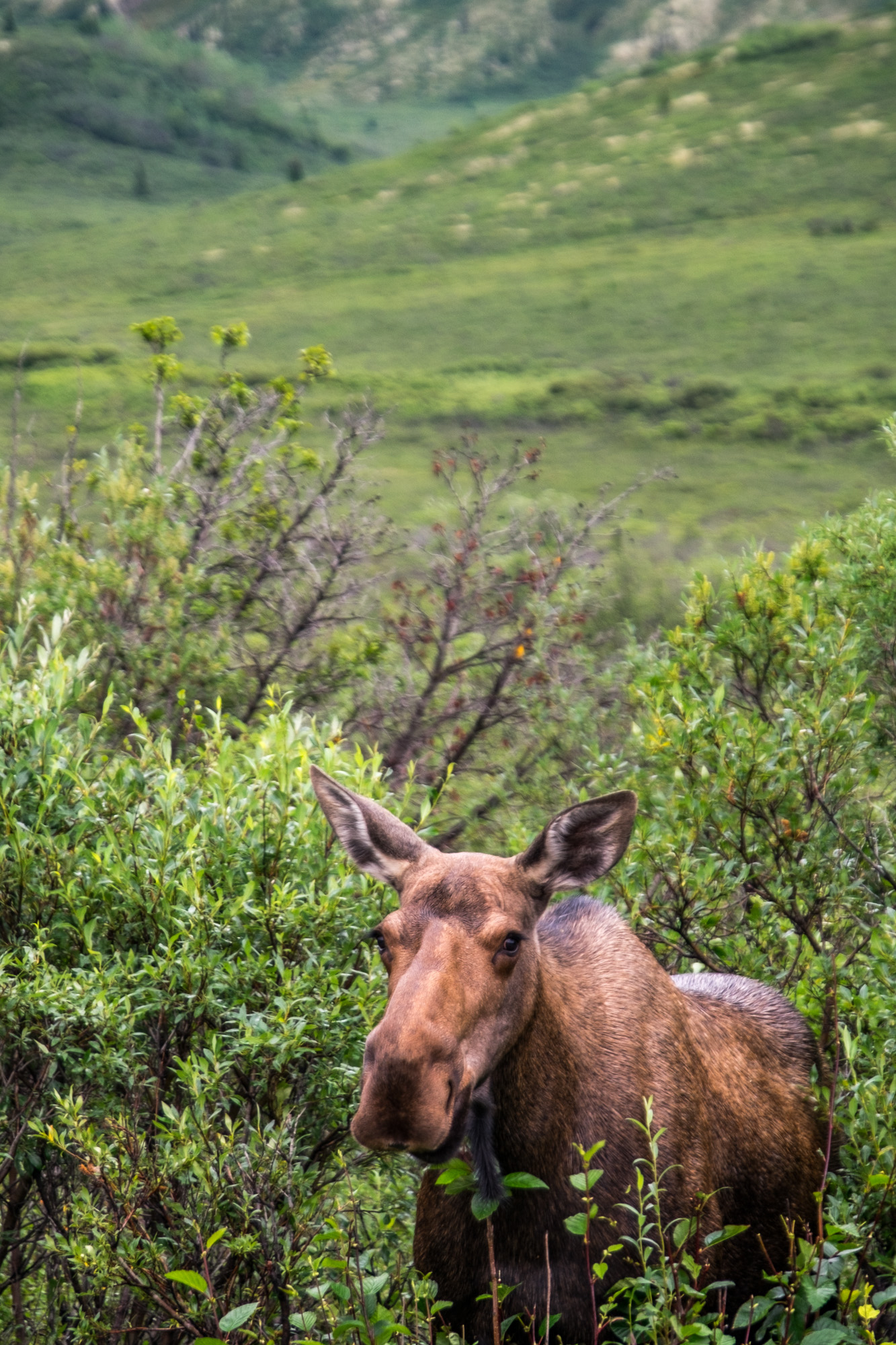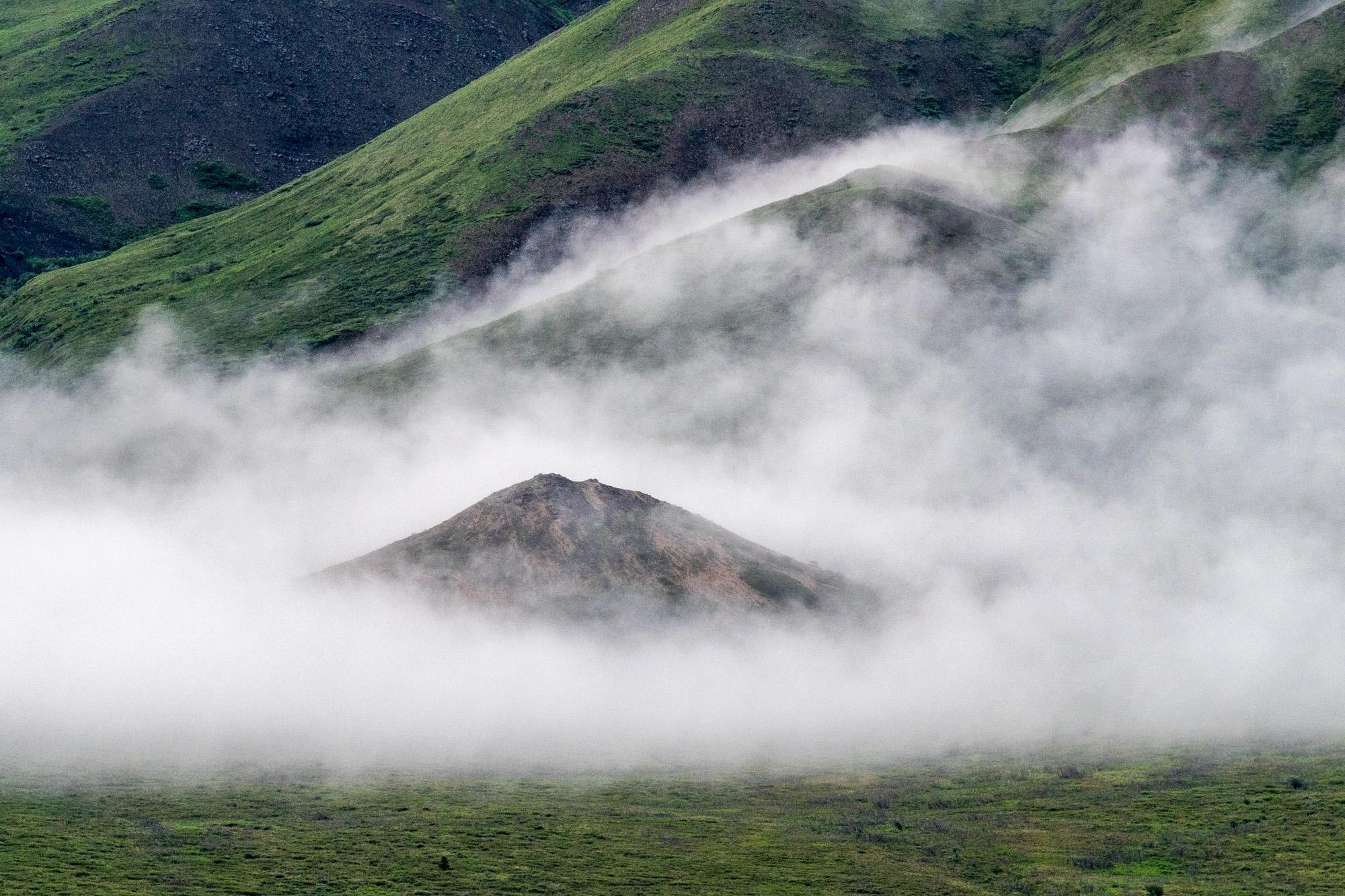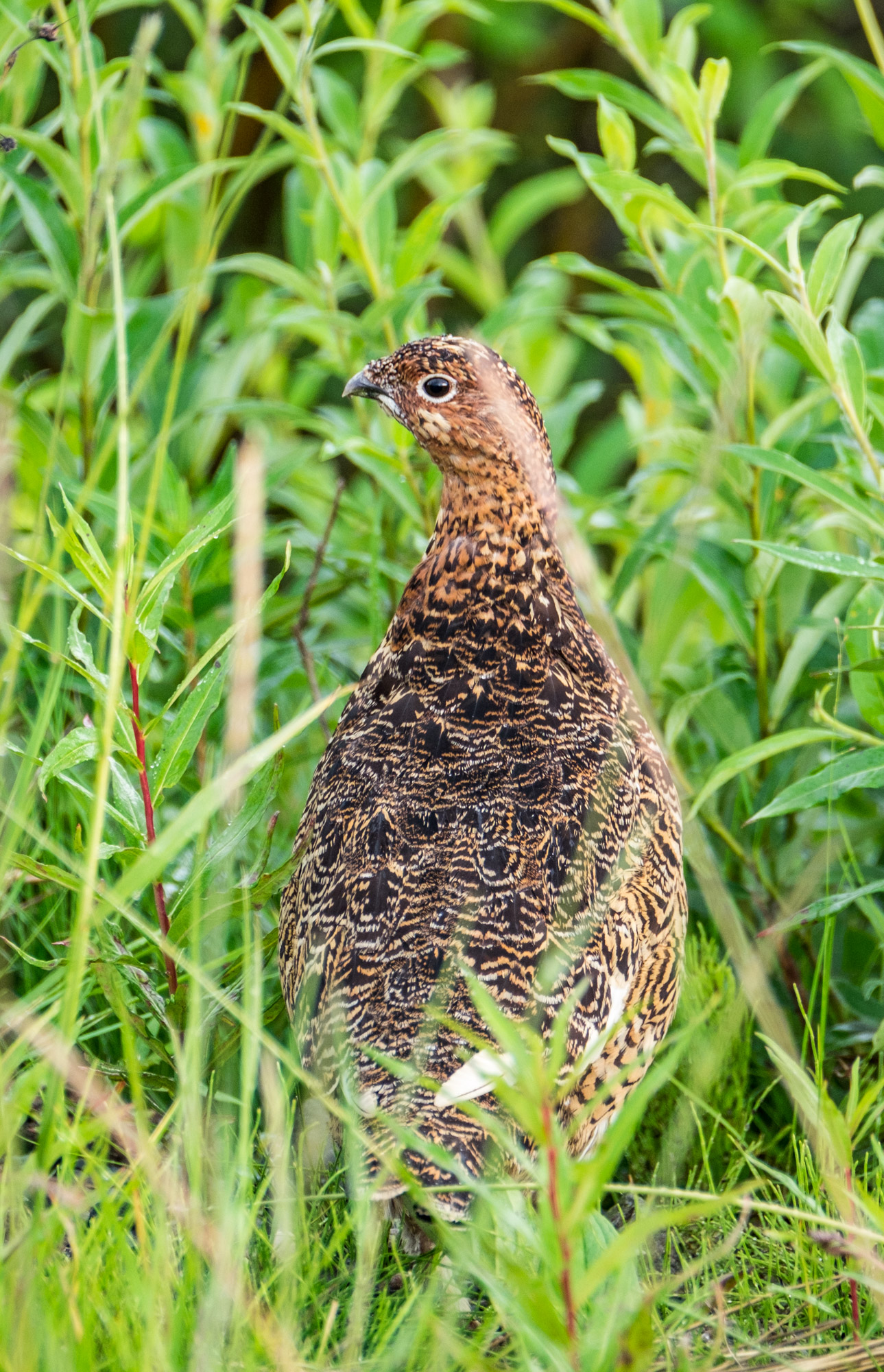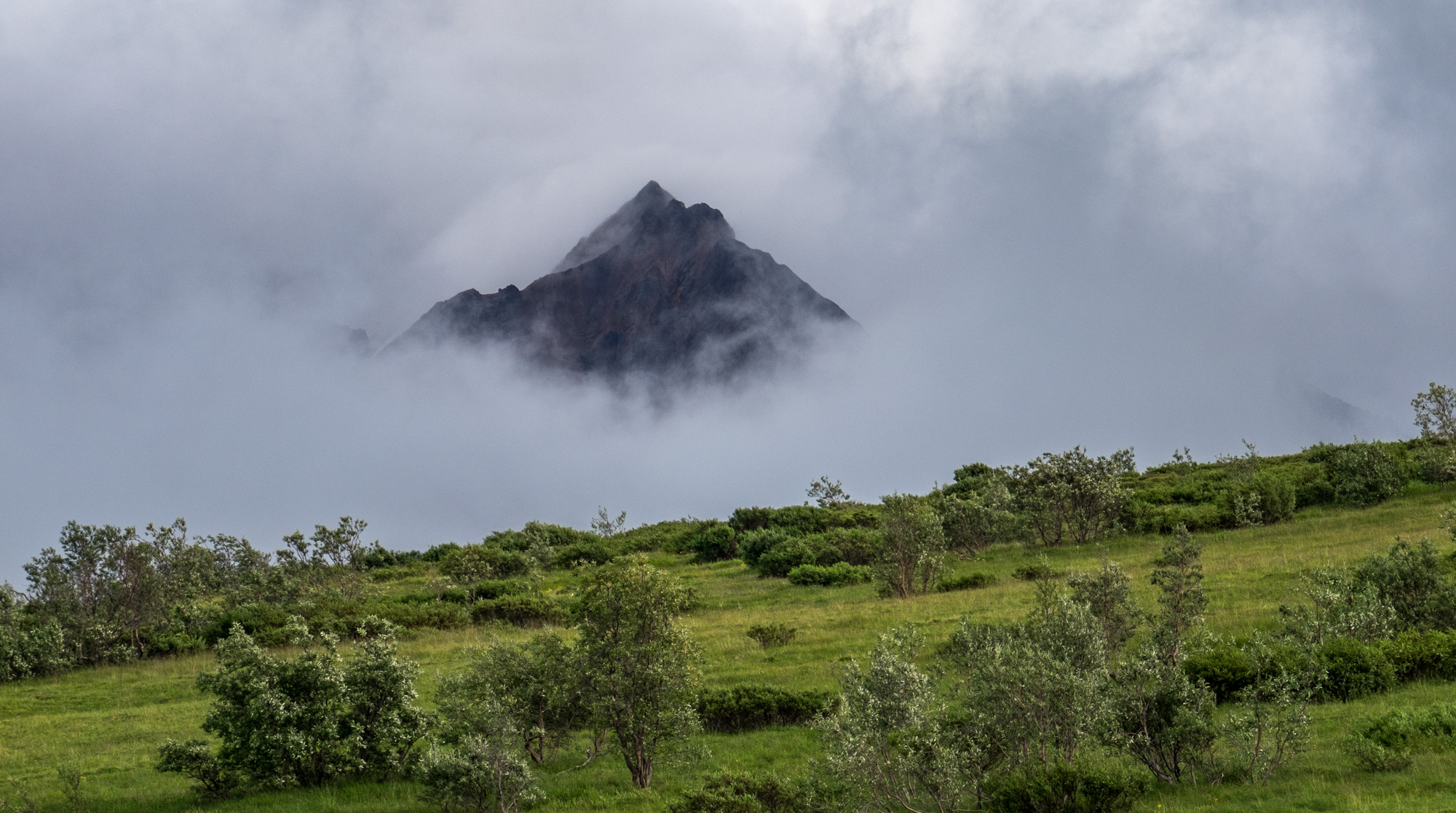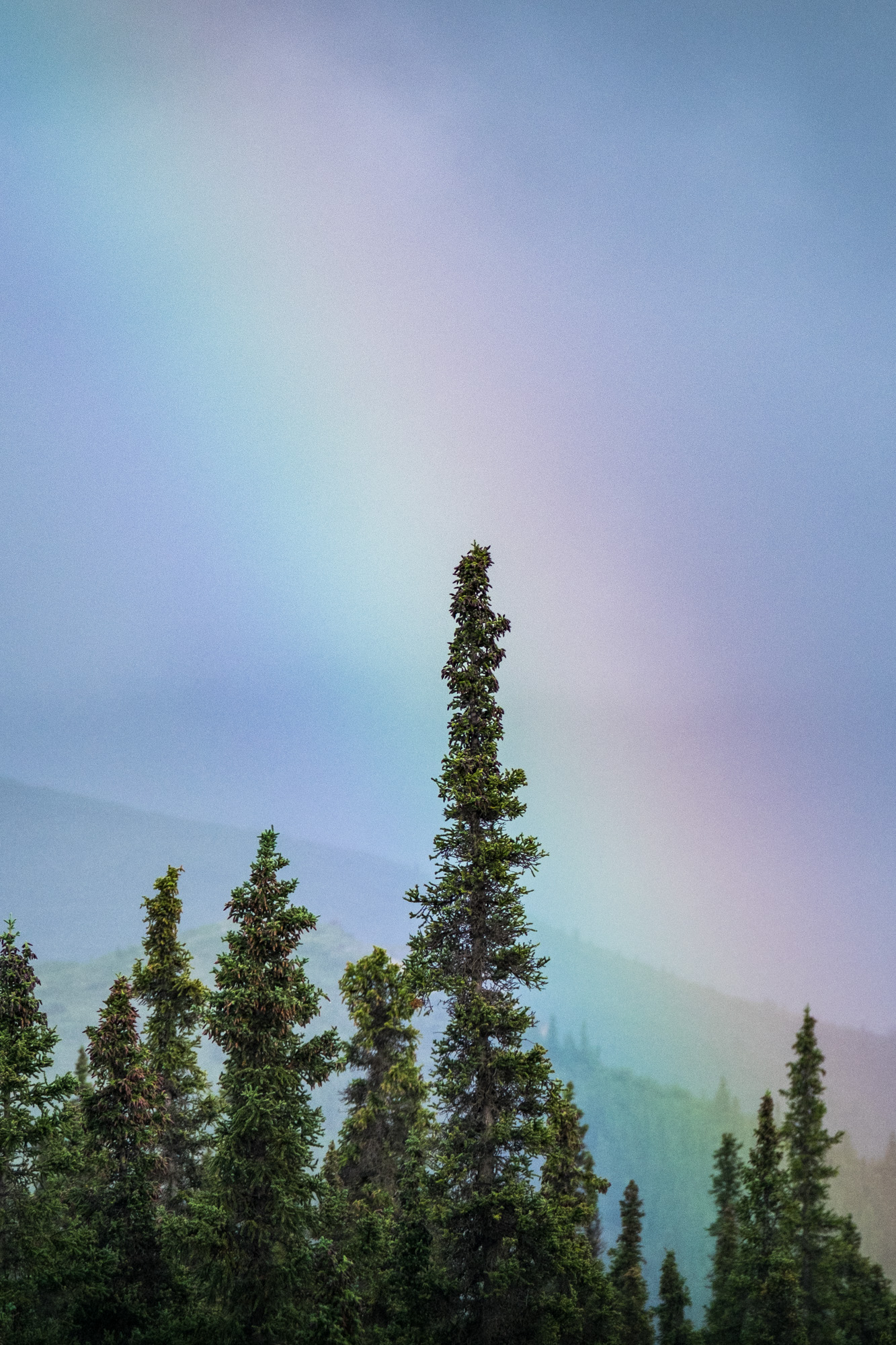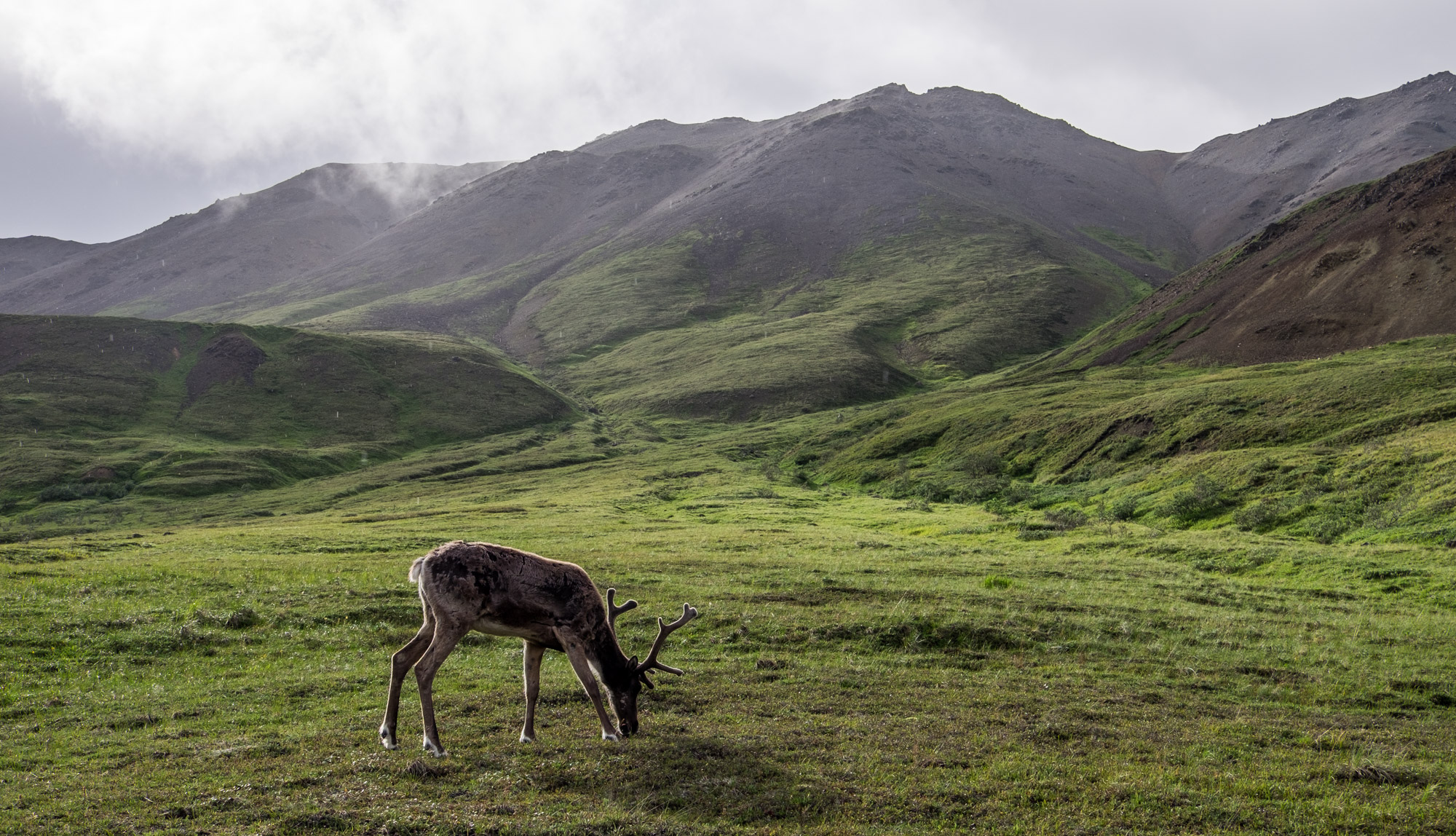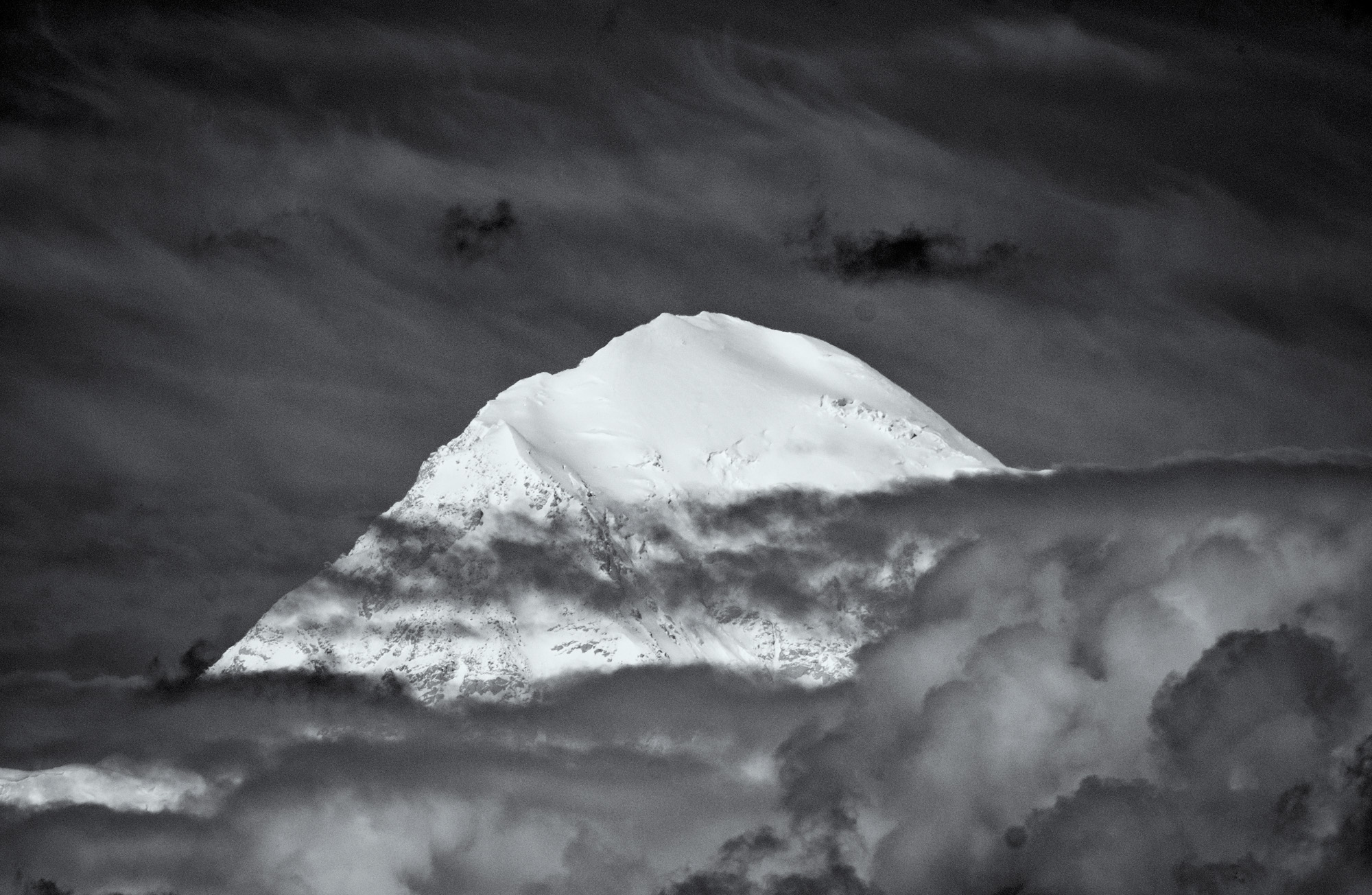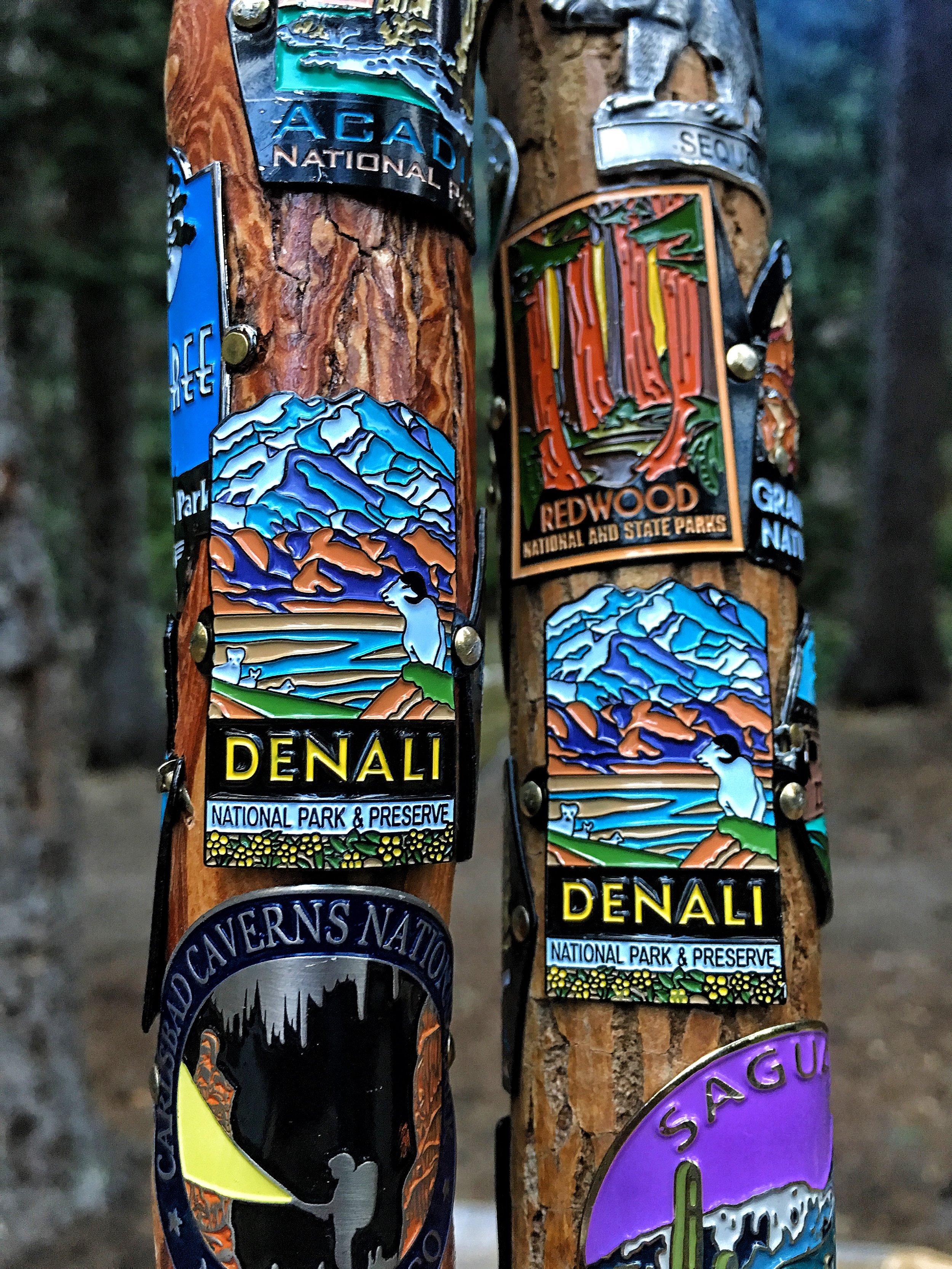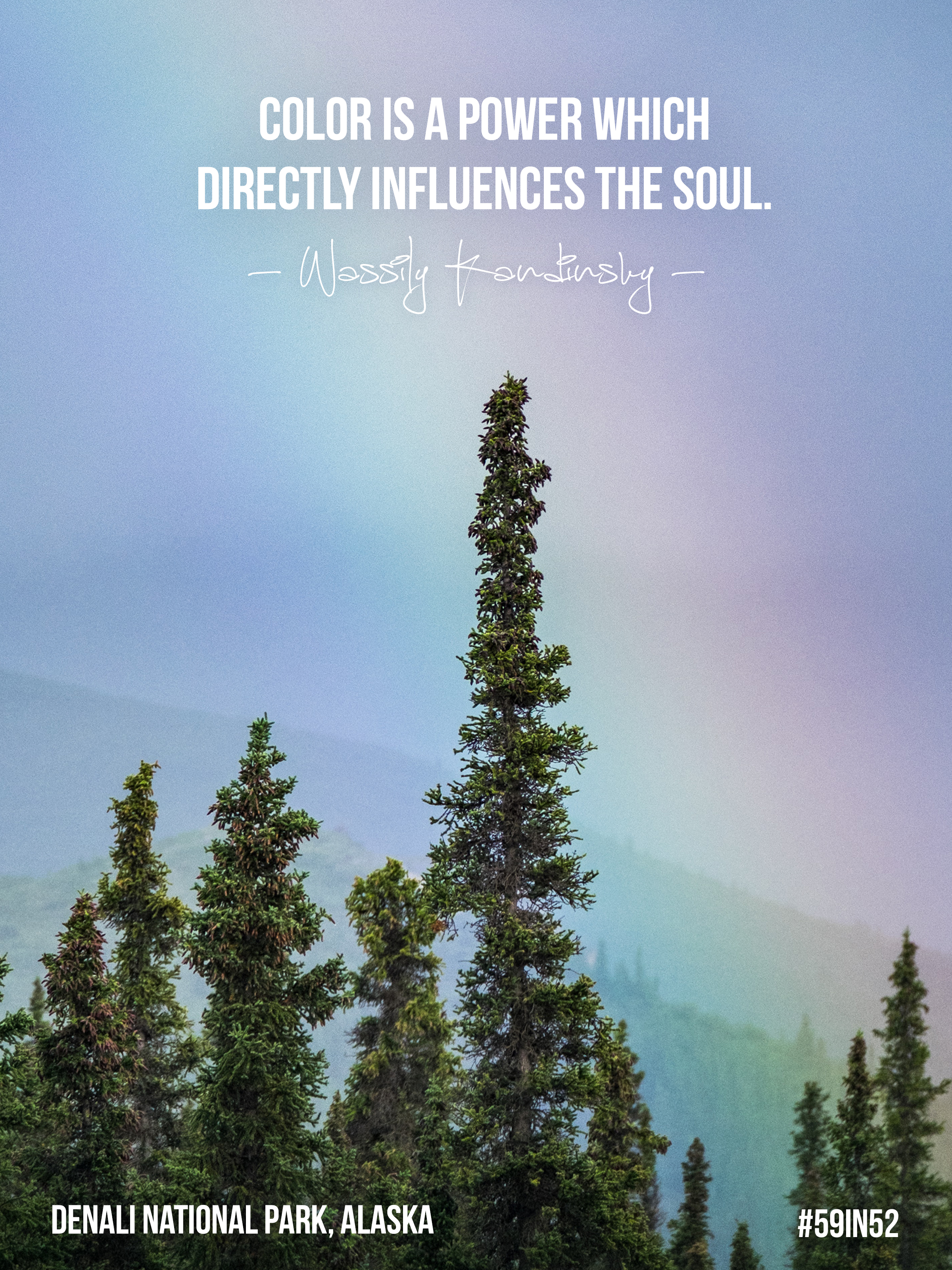Denali National Park, Alaska, USA | Park 33/59
American Safari in Denali National Park
A grizzly bear reminds motorists to obey road rules in Denali National Park in Alaska.
To look out onto the wildness of the open Alaskan tundra, you will start to understand why Denali is the most visited and well-known of all of Alaska’s national parks—it's a place that personifies wilderness.
Where the wild things are, we go in Denali.
Denali (formerly Mt. McKinley) National Park in interior Alaska is home to the highest peak in North America, and you would think that it is that distinction that earned it National Park protection. It was, however, the first national park that was protected as a wildlife habitat and sanctuary. In the early part of the 20th century, after spending a great deal of time in the area observing wildlife species, a naturalist named Charles Sheldon began approaching Congress about setting aside the land he loved so dear so that poachers and hunters wouldn’t destroy the populations of birdlife, caribou, wolves, moose, grizzlies, and Dall sheep that inhabited the region. His efforts proved successful and in 1917, President Woodrow Wilson established Mt. McKinley National Park—Alaska’s first national park.
One hundred years later, thanks to Sheldon’s efforts, we as visitors are able to head out into the wilderness of Alaska on what we can only compare to African Safari—American style. In the African bush, wildlife lovers are in search of "the big five"—lion, leopard, elephant, rhino, and buffalo. In the Alaskan wild, also referred to as “the bush,” visitors seek glimpses of the American Big Five: wolves, Dall sheep, caribou, grizzlies, and moose. Guided bus rides are spent searching for animals in their natural setting. Grizzly bears appear as golden thimbles on the expanse. Moose stick their prominent noses out of the brush. Elusive wolves and lynx can be spotted in the early morning and late afternoon in search of food. Alaska’s state bird, the Ptarmigan, wander among the lowland trees. Golden eagles fly overhead. It’s as if time has stood still here; animals conducting themselves as they have for millennia.
The Denali landscape scenery is no less extraordinary than the animals living in its vastness. Taking a macro view, you will see the soft beauty of a Renaissance-era landscape painting. Focusing in on the components, you will begin to see all of the little details that make the painting view even more incredible—the braided rivers, the spruce trees, open tundra, boreal wetlands, and of course, the wildlife that calls it all home.
Denali, "The Great One," in black and white.
And then there is the mountain—Denali—the tallest peak in North America standing at 20,320-feet above sea level. The word “Denali” is native Athabascan for ‘The High One’ or “The Great One.” It is so high that it creates its own weather system rendering it invisible two thirds of the time, meaning that many visitors may never see the fabled peak during their time in its midst. On the bright side, there is so much else to see and do at the park that you won’t feel like you’ve missed a thing by the time you pack up to leave, whether you see the mountain or not.
Denali National Park is 6 million acres in size, and in that space there is only one driving road. Even the most basic math skills will tell you that those two factors make it a challenging place to safely explore. That lack of easy access can be greatly limiting. But that’s part of the draw—once you figure out how to get out there, you will find yourself without anyone else around for miles—tens of miles; hundreds of miles, thousands upon thousand of miles.
In that spirit, we wanted to concisely outline several popular ways to get into Denali National Park and Preserve, and some awesome stops to check out while there. Read on!
A concessioner-operated tour bus on Denali Park Road, the only road in the park, stretching 92 miles.
Denali Park Road
Denali Park Road is the only road in the national park. Private vehicles can travel 15 miles of it, and beyond that, its 92-miles must be explored aboard a concessioner-operated tour/shuttle bus that offers daily trips to the road’s end. The narrated, scenic drive through the park is geared primarily to wildlife viewing, the most commonly seen species being grizzly bears, moose, caribou, and birds. While you may get lucky and see wildlife on or near the road, you will most likely see them from a bit of a distance so bring binoculars and/or a telephoto lens to get a closer look.
Concessioner operated shuttle busses also facilitate multi-use access allowing riders to hop on and hop off at popular backcountry areas and campsites along the road so they can more easily get off the tourist trail and explore the park on foot.
To make arrangements for any and all types of bus tours in Denali, head to the Wilderness Access Center near the park entrance and plan in advance due to the popular nature of the experience.
Wally the Airstream found a sweet spot in the Teklanika campground, located 30 miles in on Denali Park Road.
Camping & Hiking
Camping is without a doubt one of the most cost-effective ways to experience the park in a more intimate way. Established campgrounds are situated up to 30 miles along Denali Park Road and must be reserved in advance. As private vehicles are only allowed 15 miles of access, campers are granted a special road permit with their reservation to drive to and from the campground that they are staying at only once (there are guards along the way, so no funny business!) Whether tent camping or boondocking with your RV or travel trailer (Wally was so happy at the Teklanika campground!) you will have the wilderness on your doorstep in every direction and can set off to explore wherever you want from there—a way into the wild!
Backcountry Camping
Denali is a wide open and trail-less expanse that satisfies perfectly those who want to get off-grid and sleep in the wild while setting up their own accommodations along the way. You have to have some backcountry chops to take this on—dangerous wildlife roams free throughout the entire park, weather changes on a dime, and services and emergency help are few and far between and sometimes, days away. Backpackers in Denali have to be armed with their fair share of self-sufficiency and survival skills. Once you have that squared away, you are free of all of your common tethers in Denali’s stunningly rugged wilderness.
To engage in a comprehensive look at the breadth of Denali's 6-million acre landscape, hop on a bush plane and enjoy a flightseeing tour!
Flightseeing Tours
If you can drop a bit of coin, a flightseeing tour by plane or by helicopter is a great way to get a comprehensive glimpse of the vastness and intricate beauty that makes up the landscape of Denali National Park and Preserve. Cost per person typically starts around $200 an hour, and goes right on up depending on where you go and what type of trip you take. For companies operating in the area, we refer to the Denali National Park flightseeing page which offers up plenty of recommendations.
Lodges
There are a few lodges at the end of Denali Park Road that offer a close proximity to Wonder Lake—a great viewing point for the mountain when it decides to show itself—including Camp Denali, the North Face Lodge, and the Kantishna Road House. To stay in a lodge in the park is no easy or inexpensive thing, and it is often the type of experience that people save up for a long time for to be able to do. As these lodges offer the cushiest deep-into-the-park experience, they book up well in advance so if this is your jam, plan ahead.
Quotable Images
Fact Box
6.2 million acres | Home to the highest peak in North America | UNESCO International Biosphere Reserve
Official name: Denali National Park and Preserve
Date established: February 26th, 1917
Location: Interior Alaska, 240 miles north of Anchorage.
How to get there: From Anchorage, drive or travel by train on the Alaska Railroad north about 240 miles until you reach Denali. From Fairbanks, head south about 125 miles.
“With our own sense of reverence for this place, we are officially renaming the mountain Denali in recognition of the traditions of Alaska Natives and the strong support of the people of Alaska.”
How the park got its name: To native Alaskan Athabascan peoples, North America’s highest peak and the wilderness surrounding it has always been called “Denali.” Many still know it as Mt. McKinley. Both names lend insight into a complicated past...
In 1897, a local Alaskan resident gold prospector named William Dickey who was jockeying President William McKinley for support in gold rush efforts in the area called the mountain “Mt. McKinley” in an article that ran in a New York newspaper called The Sun. Through good press, the name stuck and (making a long story short) in 1917, Mt. McKinley National Park was established under the order of President Woodrow Wilson.
This naming convention has been a real problem for Alaskan’s since the beginning of park protection in the area as President McKinley had never actually set foot in the state. The situation took a turn in 1980 when the mountain (Denali National Monument) and the national park (Mt. McKinley National Park) merged as part of the Alaska National Interest Lands Conservation Act to become a combined national park unit—called the “Denali National Park and Preserve.” It was still referred to as "Mt. McKinley" by the official Alaska state Board of Geographic Names and both the mountain and the national park were mistakenly still called Mt. McKinley on public record.
The drama finally came to an end in 2015, when President Barack Obama exercised statutory authority, instructing Secretary of the Interior Sally Jewell (a former CEO of REI) to rename the park to its native "Denali." As McKinley was assassinated while in office, this action is under scrutiny, specifically by the people of Ohio. Nonetheless to Alaskans, it is called now what it should be and should have always been called: Denali.
Denali, meaning "The High One" or "The Great One" in native Athabscan, is the highest peak in North America, standing at 20,320 feet above sea level.
Iconic site in the park: Denali, also known as "The High One" or "The Great One", is the tallest mountain in North America. It stands 20,320 feet above sea level and continues to grow at the rate of a millimeter every year. There is so much wind at the high elevation that the mountain creates its own weather system, shrouding it with clouds 70 percent of the time—meaning that only approximately two thirds of all visitors to the park will see the mountain during their visit. On the eve of the start of the 100th anniversary year of the National Park Service, the name "Mt. McKinley" (as it has been called for nearly a century) was restored to what natives have called for thousands of years: Denali.
1,500 climbers are permitted to attempt to summit each summer season—85% of them ascend the West Buttress route as it is the least technical. Only half who make the attempt will reach the top. The harsh conditions of wind chill and subzero temperatures make the endeavor extremely dangerous; oftentimes, people get stuck for many days at a time and in more tragic scenarios, climbers have been blown right off the mountain. Climbers of Denali with whom we've spoken to have said that patience is your best equipment on the mountain.
A grizzly bear crosses the path of a tour bus on Denali Park Road.
Accessible Adventure: Heading out on a concessioner-operated bus on Denali Park Road is by far the most popular and easy way to venture into the park. On a 4.5, 8, or 12 hour bus ride—that's right, on a school bus—visitors will see incredible wilderness landscapes and a variety of wildlife including grizzly bears, caribou, moose, sheep, arctic ground squirrels, birdlife, and if you are very lucky, Denali, the highest peak in North America. The road weaves along mountain passes that were carved out in the early 20th century to allow for better views of the decorated valley floor. This experience is a great introduction to the park and offers for some an idea of how to explore it deeper.
Big adventure: There are two big adventures we want to highlight in Denali—the first is the biggest of them all, is the quest to climb Denali, the highest peak in North America. The second is a big adventure in a different way, one that allows you to get to know the landscape and wilderness intimately, and that is by setting off into backcountry on a backpacking adventure. To walk on pillowy tundra, wander the washes of the braided rivers, and sleep beneath the stars in a trail-less wilderness will expose the Alaska's most visited national park in a really unique way. Only when you are completely on your own will you start to connect with the depth of the wilderness that has drawn explorers to Alaska for centuries.
Did you know...
If you explored 1,000 acres a day, it would take you ten years to discover all of the wilderness landscape at Denali National Park.
Denali is the only national park to be established solely for purpose of protecting wildlife.
Denali is the tallest Mountain in North America standing at 20,320 feet. It is so high that it creates its own weather system and as a result, clouds block it from view more than two thirds of the time during high season. The National Park Service and area locals say that you are very lucky if you even see Denali while visiting—there is even an unofficial “I saw Denali” club (which we were very fortunate to join.)
According to the PBS Ken Burns National Park series, the first summit of Denali occurred in March of 1910 when two local prospectors made it to the top and planted an American flag on the north peak. Their trail food consisted of a thermos of hot chocolate and a bag of donuts.
Denali Park Road is the only road in the park. Private vehicles can explore 15 miles of the 92-mile road, and beyond that, visitors must hop on a concessioner-operated tour/shuttle bus that departs from the Wilderness Access Center. Exceptions are sometimes made if you have a project requiring special access—such as photographing all of the national parks. If that is the case, plan on providing paperwork, detailed information, and plenty of advance notice for an elusive special access permit. You can also take your chances by participating in a 4-day annual lottery held each May which enables visitors explore as much of the road as weather will permit.
A group of hikers set off on a ranger-led "Discovery Hike."
The National Park Service at Denali offers free, ranger-led "Discovery Hikes" as a safe, interpretive way to explore and learn about the park.
Traveling by train on the Alaskan Railroad from either Anchorage or Fairbanks is a popular, historic, and totally unique and fun way to travel to Denali National Park. It has been operating since 1914.
Wildlife viewing in Denali is an American safari. The Alaskan "Big 5" include: bear, moose, caribou, wolf, and Dall sheep.
Grizzly bears are often blonde and described as straw-colored… It’s helpful to know what to look for when trying to make wildlife sightings! (Read more about grizzly bears in our comprehensive Bear 101 article.)
Ptarmigan is the state bird of Alaska and can be spotted in Denali, except for during winter time when they turn completely white to camouflage themselves from predators.
The Denali wilderness is a cross section of three types of terrain—boreal lowlands (where you will find lynx, fox, black bear, and moose); wet tundra (Dall sheep, moose, wolf, grizzly bear, and caribou); and alpine tundra (wolverine country!)
Caribou country fun facts! Caribou are the same species as reindeer. Reindeer are the domesticated (rein in the deer) version of the animal. They have hollow hairs to keep them cool in the winter and warm in the summer. If you see them standing very still like statues, it is in effort to dupe vicious biting black flies (who consume half a pint of their blood each day.)
A grizzly cub walks softly in his protected home in Denali National Park.
The ptarmigan (with a silent "p") is the state bird of Alaska.
A pair of moose in the Denali boreal lowlands.
The difference between a caribou and a reindeer is that caribou are wild whereas reindeer are domesticated.
Alaska's other state bird is the mosquito! (Kidding but not kidding.) Plentiful water sources and warm weather make Alaska a perfect breeding ground and habitat for 35 species of mosquitos that buzz the state each summer.
The clear waters of Wonder Lake -- one of the best Denali viewing sites in the park...when the mountain is out.
Wonder Lake is the most popular place to view and photograph Denali, when it shows itself. It is located near the end of Denali Park Road. Camping is available there if you book in advance.
Most vehicular activity is prohibited in Denali during the winter season (snow-machining is an exception in certain areas.) Traveling the backcountry by dog sled, snow shoes, and/or on cross country skis are all popular ways to enjoy this incredible winter landscape.
Athabascan peoples, native to interior Alaska and those who gave Denali its name, speak 11 different dialects and are recorded to have lived in the area for several thousands of years.
Fossilized remains of plants, animals, and dinosaurs make Denali National Park and Preserve one of the most important paleoanthropological record sites in North America.
There are more than 80 archaeological sites documented within park boundaries.
Evidence of humanity has been found most recently at Sable Pass, and elsewhere, at the Teklanika River, dating back to 7130 BC.
Denali the mountain and Dall Sheep are featured on the America The Beautiful quarters series released by the U.S. Mint in 2009.
Alaska’s northern latitude extends daylight up to 20 hours each day in this area of Alaska during the summer season (in the north, daylight lasts for 24 hours, a phenomenon known as the “midnight sun.”) The lack of darkness makes it difficult to see stars and the Aurora Borealis (Northern Lights.) The best time to check out the auroras in Alaska is during the spring and fall.
Denali National Park and Preserve in Alaska, home to 6.2 million acres of wild Alaskan mountains, rivers, forests, wetlands, and the wildlife that calls it all home.
For those of you who devoured Jon Krakauer’s book Into The Wild and/or the film of the same name directed by Sean Penn, you might already know (or want to know) that the area surrounding Denali is where Christopher McCandless lived and died, just outside of the park boundary in the area of Cantwell.
It should be acknowledged that most Alaskan’s aren’t in awe of the existential plight of Christopher McCandless of Into The Wild fame. Many residents of the area feel that he got what he prepared for—they themselves would never head off into the Alaskan backcountry unprepared, without food, without equipment, without gear. His plight to find meaning in living in simplicity was romantic for sure, but not the way of a true Alaskan. All the same, many are drawn to the story of Christopher McCandless, and we are no different—otherwise, we probably wouldn’t have found ourselves at the 49th State Brewing Company in the town of Healy near the entrance of the park. So glad we did though, because not only did we get a chance to bag photos of a replica of the famed “Magic Bus” that was used the film, but we also found a great brew pub right next door to a national park—a surprising rarity this year. Visit our Stops Along The Road section to get the lowdown on the brewery and the famed “Magic Bus” from the film Into the Wild, where we refueled after a long day of hiking on the tundra while paying homage in our own way to Christopher McCandless, and his life and death in Alaska.



